
Return to home page
Other blogs/sites I follow: Christine Allen's // Gordon Price's // Ray Ison's // Sarah Jane's photo site // Travel Painting Blog // Roland Hemmert art site
Go to the Elizabeth Flats (our rental apartment) site
| April 29, 2008:
further evidence of the paucity of talent in Oz's State governments was
provided today. The Liberal leader of the opposition in WA (Western
Australia) admitted that he had indeed sniffed a chair just vacated by
a female staffer. Would the party get rid of him? No, said the news
report, as the party felt he was the most able of all their elected
members. |
April 28, 2008: 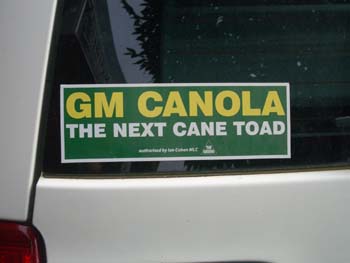 -Genetically modified foods have only just been approved in some areas of Australia, after a rancorous debate. Due to the environmentalist sympathy that dominates the Blue Mountains, it's not unusual to see this bumper sticker -- the reference being to the toads imported into Queensland a lifetime ago to eat a nasty beetle. But the cane toads turned out to be a much bigger disaster, among the biggest environmental messes on this supposedly-quarantined island (uh, continent). They've spread over a huge area, destroying the native fauna with every hop. One of the funniest wildlife documentaries ever produced is the 1988 Cane Toads, by Mark Lewis, but the toads themselves are no joke. In addition to being prolific and rapacious, they're also poisonous to anything that tries to eat them, so they're even taking out the native predators. 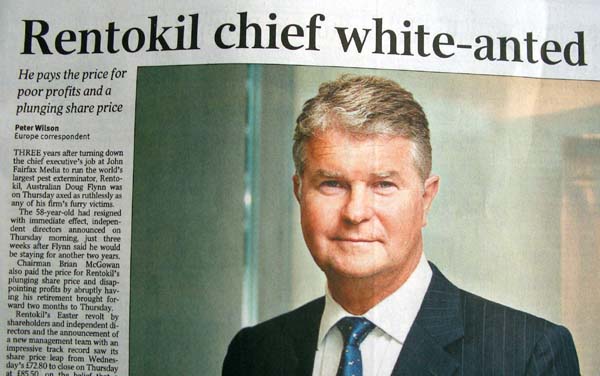 There is
no noun in Australia that can't be verbed, as it were, in the headlong
rush to speak faster. Beyond the obvious pun, as Rentokil is a
pest-extermination business, the headline explains that the boss's
position has
been undermined, exactly what white ants do to timber
houses, especially in the tropical north. "White-ant," as a verb, is in
the dictionary.
- one upshot from the election of a new prime minister and government is to see the Republic issue back on the table. Kevin Rudd, when meeting the Queen in London a few weeks ago, told her that while he was in favour of Australia severing the monarchy's role he wouldn't push for it while she was still on the throne. A polite chap. And in last weekend's 20-20 ideas gabfast in Canberra, the demand for a republic came out loud and strong, led by the FOK-ers (Friends of Kevin...). A first start, in my opinion, would be to get rid of the old colonial flag -- the ensign with the Union Jack in the top left and the Southern Cross on a blue field. It's 43 years since Canada shed its ensign, so c'mon Australia -- get with it! I may put together some suggestions to help 'em along. 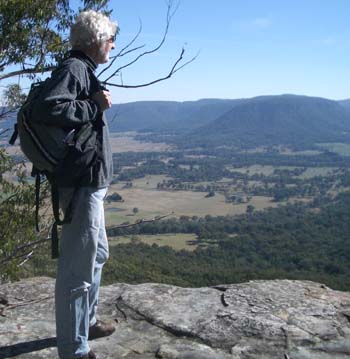 Another week, another hike. Brother-in-law Doug and I headed for Mount York on Saturday morning, leaving Christine and Caroline free to go to a plant fair unencumbered by mutinous husbands. We followed the 1813 wagon trail, which more resembled a goat track, that connected the westernmost edge of the Blue Mountains with the fertile plains below. It's called Cox's Road, and was built in a great hurry by a gang of whip-driven convicts down a slope so steep that the wagons had to be lowered by ropes. Once down the escarpment, it winds through a pastoral landscape of bushland and graziers' fields. A mob of kangaroos were the only creatures disturbed by our passing. 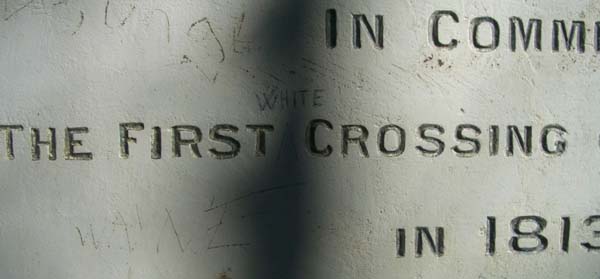 There's
a grand obelisk
at the start of the trail, erected a century ago. Although not
generally in favour of the defacing of public monuments, I liked the
editorial comment scratched into its face. The surviving part of Cox's
Road where we hiked ends at Hartley Vale, a hamlet about 4 km. from the
start; at that point, we began the ascent back up out of the valley
along Lockyer's Road, an 1830s alternate path that climbs quickly up to
a ridge,
then follows a more gradual slope to the trans-mountains route back to
Sydney.
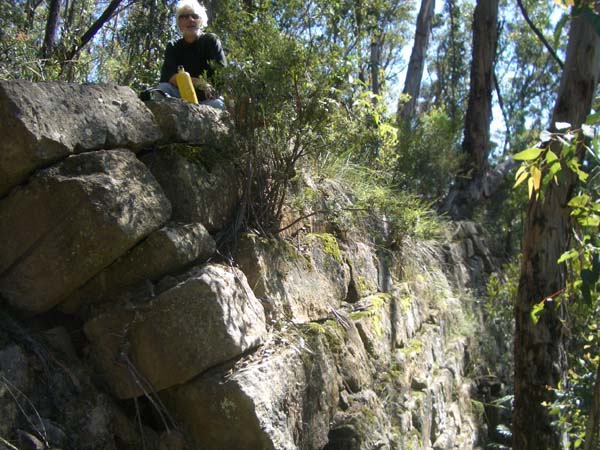 The photo above shows one of the rock retaining walls built by convicts high up in the bush. Like, this would've been serious lifting. Then, we came upon the cruelest of all jokes, a sign a few steps further along saying that the road construction was abandoned there because the Surveyor General in 1832 had decided he favored yet another route: Victoria Pass. So the convicts were pulled off Lockyer's Road and, presumably, frog-marched across to the new one. We were imagining the situation, inexplicably adding German accents: "Men, ve hef some good news unt some bad news. Ze good news is dat you don't hef to vork here any more ...." Well, I guess we were getting tired. 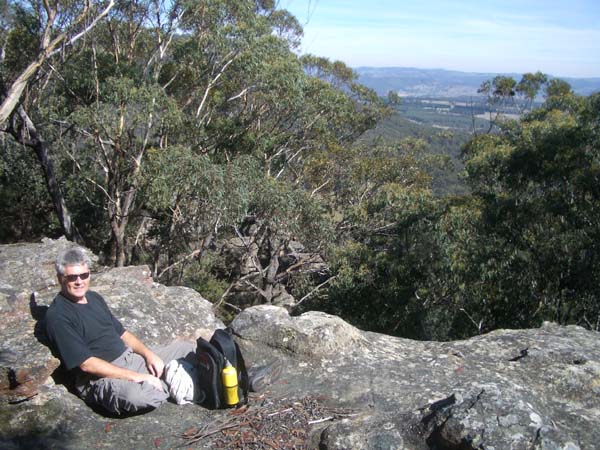 Relaxing after the worst of the climb -- Doug at lunch on a stone "pagoda" high up on the ridge. The hike took about 4 hours for the 10+ kilometres, followed by some serious rehydration at a hotel pub in Blackheath on the way home. |
April 19, 2008: 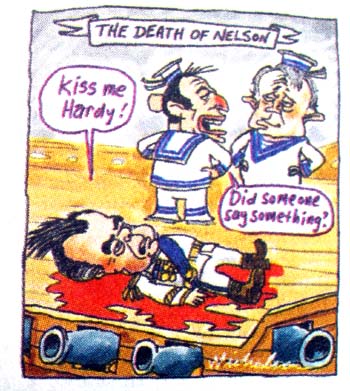 -Time for a bit of a news and hiking roundup. Following his Beijing trip the new prime minister is riding high in the polls, with an approval rating above 70%, while his hapless rival Brendan Nelson has slipped back into single figures. The Nicholson cartoon ripped off from last week's Australian nicely captures the attitude of many of his Liberal party colleages. The clever headline writer in that paper described him as the "Nearly Departed." And the country is currently in the thrall of the PM's "20-20" ideas summit, with the "best and the brightest" meeting over the weekend to try to put forward some new ideas that will become policy. It's either a colossal waste of time or an interesting exercise in government-openness, depending on whom you listen to. But the real news dominating the airwaves is the fate of 20-year-old Olympic swimmer Nick D'Arcy, who has been banned from the Beijing team after an altercation with a former swimmer outside a Sydney nightclub a couple of weeks ago. They had a fight after too many drinks, so big deal? say some. But D'Arcy's victim suffered a broken nose and jaw (which is now wired together) and will eventually emerge with 10 titanium plates in his head following the brutal beating. Allegedly, D'Arcy went berserk, and also allegedly it's happened before. This is only the most highly publicized of recent events involving drunken youth. An article in the paper this weekend entitled "Backfire of the Vanities" explores why so many young people seem to lack "the empathy gene." D'Arcy will appeal, he says, citing the case of professional rugby player Barry Hall (who looks a lot like my drawing in the April 11th entry below) who out of nowhere spun around and knocked cold an opposing player with a left hook, then received just a 7-week suspension. Now, if that guy could skate he could make the big bucks in North America! 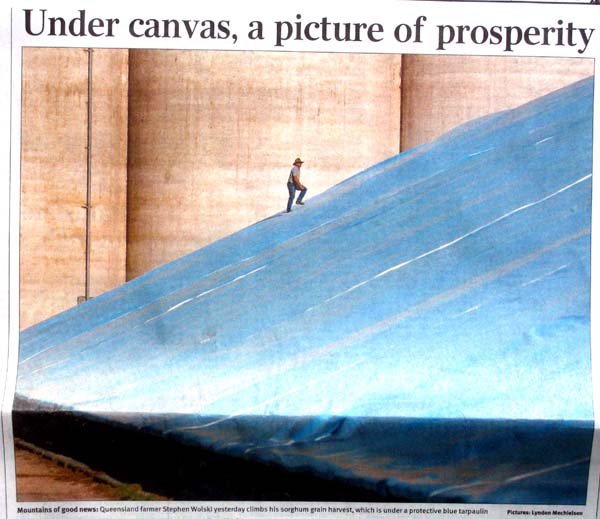 ... and, further to
the news that the drought in Australia was sure to guarantee food
shortages, this photo appeared in the paper of a Queensland farmer with
his sorghum crop, which was equal to his total harvest of the past 10
years. A lot of rain in the "second," non-drought Australia -- the
strip to the east of the Continental Divide (where we live) -- has
thwarted the projections. However, much of the traditional breadbasket,
in areas such as the Murray-Darling basin, is still suffering.
- meanwhile, we hike and explore around the Blue Mountains. In the last week there were two opportunities to get out into new terrain. The first was a walk along the old Berghofer's Pass road at the western end of the Blue Mountains with a group from the National Trust. 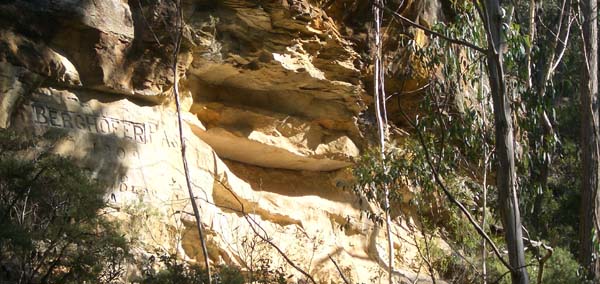 The
western end of the mountains has a very steep descent down onto the
plains near Bathurst. Four of the five historic roads survive as hiking
trails, while the fifth is the Great Western Highway, the 1831 route
that's still in use. The Berghofer Pass is a beautiful, graded roadway,
created a century ago because early motor vehicles couldn't make the
steeper grades of the highway. I photographed "Berghofer 1909" cut into
the
sandstone at one point along it. All things being equal, I'm going to
hike two of the other routes with my brother-in-law Doug later this
month, while Christine and her sister go to a plant fair.
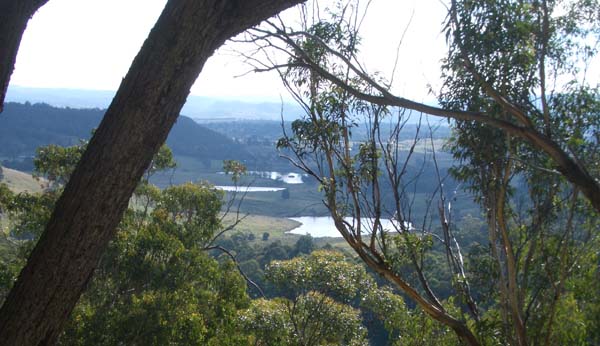 A view down onto the pastoral landscape at Little Hartley from Berghofer's Pass. 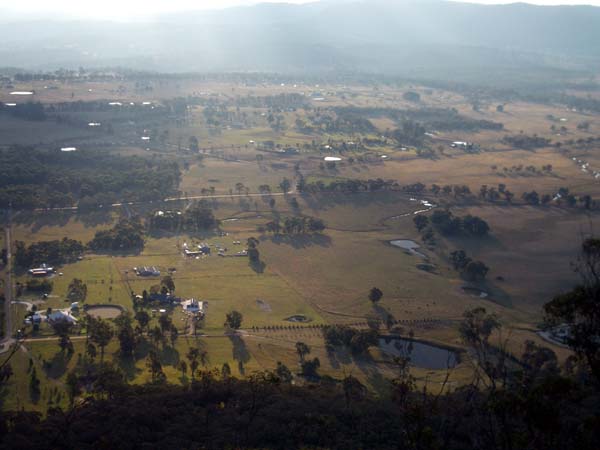 Berghofer's road climbs up the side of Mount York, which is the "end" of the mountains. There, in 1813, the explorers Blaxland, Lawson and Wentworth came to the cliff-edge at this point and saw fertile, rolling land stretching away from them. Upon their return to Sydney, work commenced to build the road over the mountains that "saved the [penal] colony" by providing enough agricultural land to feed it. It was about 4 in the afternoon when we got there. 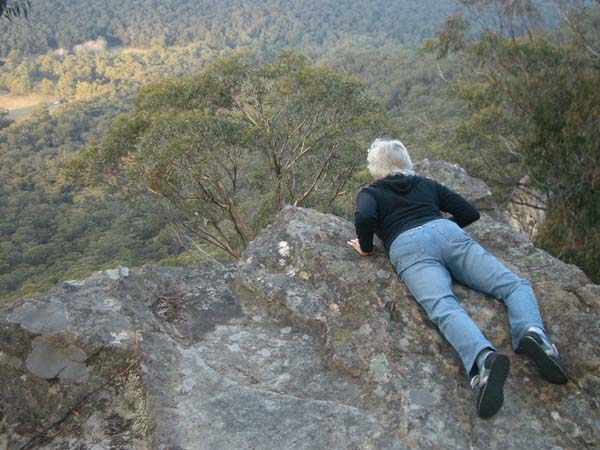 ... Christine inspecting the view over the cliff-edge at a point nearby. 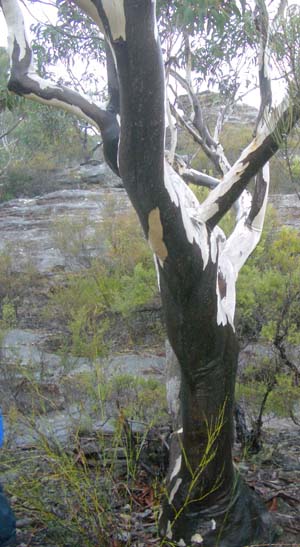 Yesterday was the
much more challenging monthly hike with the
Mount Wilson bushwalking club. I don't think either of us really
considered that we would be doing this much hiking when we chose to
live in the Blue Mountains. Instead, when we were comparing different
places we could live, we were weighing the proximity to Sydney and the
rellies, the vibrancy and architectural interest of the towns, climate
and other issues like affordability. The mountain towns get the tick
for all of them, except possibly climate (it's bloody cold here in
winter) and have the advantage of being in the middle of a huge area of
national parks laced with walking trails. Yesterday was the
much more challenging monthly hike with the
Mount Wilson bushwalking club. I don't think either of us really
considered that we would be doing this much hiking when we chose to
live in the Blue Mountains. Instead, when we were comparing different
places we could live, we were weighing the proximity to Sydney and the
rellies, the vibrancy and architectural interest of the towns, climate
and other issues like affordability. The mountain towns get the tick
for all of them, except possibly climate (it's bloody cold here in
winter) and have the advantage of being in the middle of a huge area of
national parks laced with walking trails. This walk actually started in the Village of Mount Wilson, about 25 km. from us in Katoomba as the kurrawong flies but a 40-minute drive, as the road has to skirt the impenetrable Grose Valley. It was a cool, showery autumn day, with a destination of the Wollangambe River and the Clarence Creek Canyon; as with all of the walks, they begin with a steep descent from the "plateau" height of the village, down a rough trail through bushland that had been burnt over a few years earlier. The photo shows a tree like a Holstein, actually a "scribbly gum" whose new, white bark is gradually replacing the charred remnants from the bush fire. It and the low shrubs appear to be growing out of pure sandstone, and they are. The name scribbly gum comes from the "scribbled," random marks left by insects on the trunks. 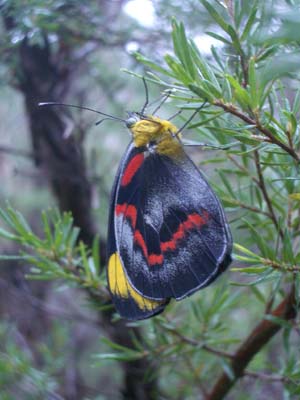 ... a butterly hanging out by the side of the trail 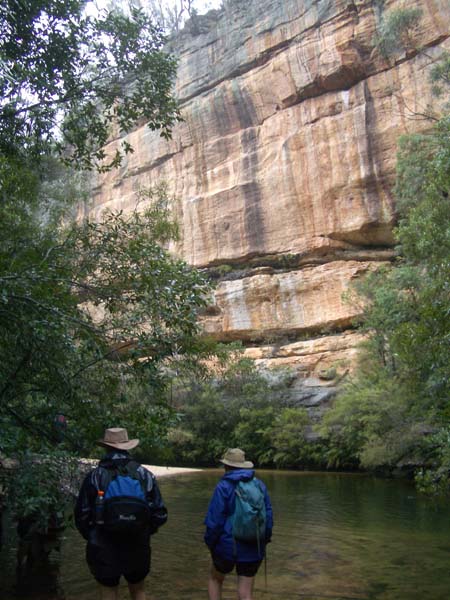 We
took sneakers to change into as we had to wade a considerable distance
along
the creek to get to the canyon. At a few spots, due to rockfalls that
choked the creek with house-sized boulders, we had to scramble up into
the bush on a sort of portage before returning to the creek.
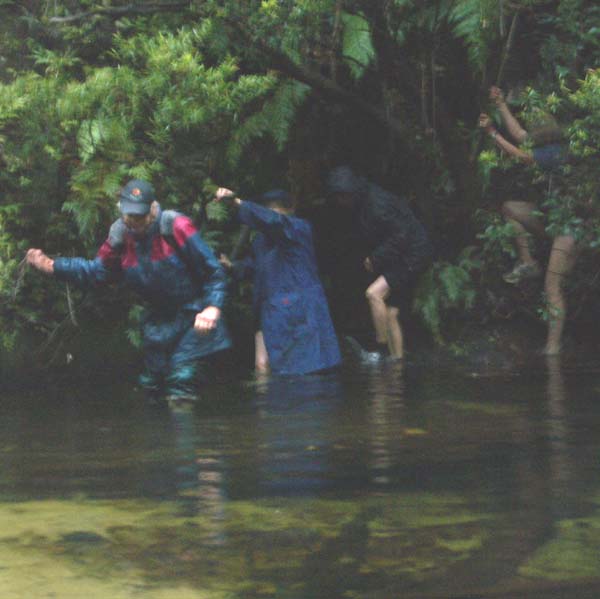 ... it was rough. Libby, our fearless leader, is about to step off the slippery brown rock and go in about waist deep. Even I, with my long legs, got immersed up to crotch level. Ugh. But the water was amazingly warm, at least compared with the snowpack-fed streams of my British Columbia past. |
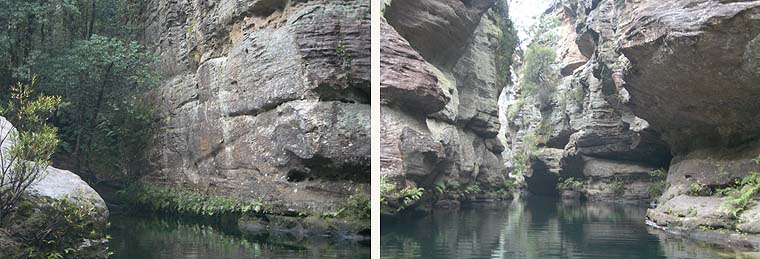
| ... and finally, the Canyon. I was standing above my knees in the flowing water and trying not to fall over, and swung the camera just a bit too far to get a seamless panorama. This is a very popular spot for "canyoners," usually ridiculously fit young people, who hike down (or abseil) from the plateau above, inflate their Li-Lo air mattresses, and float down in the easy current. Perhaps another time. |
| April 11, 2008:
There has been no blogging for the past couple of weeks due to the
horror of ... I-N-C-O-M-E T-A-X (l'horreur de l'impôt).
It's the Canadian variety, so I have to state it in both languages. But
meanwhile .... -The Mandarin-speaking prime minister Kevin Rudd, a former Aussie diplomat who lived in China for years, has been getting top marks in the press for his outspoken criticism of China's human rights record in Tibet. This in spite of China's appetite for coal and iron ore, which is the primary reason for Australia's prosperity. His Tibet comments earlier in his world tour in the USA received a sharp rebuke from the Chinese. The torch relay here will be shortened, he won't attend its start, and he's refused the Chinese demand that Chinese security agents guard the torch on its Australian leg. It was interesting to watch the Buddhist/vegetarian/singer/Canadian k.d. lang, down here to spruik (q.v.) her new album, talking of her admiration for Australia and its leader. 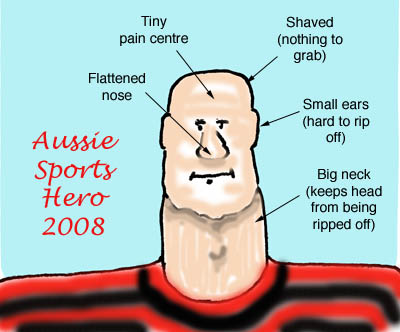 -I never thought
I'd live in a country that had as violent a game as
Canada's ice hockey, but that was before I discovered the NRL -- the
National Rugby League. It's the winter game here, beginning about this
time of the year, although news of the rowdy players' off-season
behaviour (substance abuse, shots fired at a group of them outside a
pub at 4 am,
fights, detox, etc.) continues year-round. One of the star players
fessed up
to his problems on TV a couple of weeks ago: the main incentive to use
cocaine, he told the interviewer, was that it made him able to drink
longer! -I never thought
I'd live in a country that had as violent a game as
Canada's ice hockey, but that was before I discovered the NRL -- the
National Rugby League. It's the winter game here, beginning about this
time of the year, although news of the rowdy players' off-season
behaviour (substance abuse, shots fired at a group of them outside a
pub at 4 am,
fights, detox, etc.) continues year-round. One of the star players
fessed up
to his problems on TV a couple of weeks ago: the main incentive to use
cocaine, he told the interviewer, was that it made him able to drink
longer!The teams have names like the Storm ("Stoam"), the Sharks ("Shahks"), the Roosters ("the chooks") and the Rabbitohs ("the bunnies" -- this is the team owned by the actor Russell Crowe -- a rabbitoh was a guy who came 'round selling rabbits door to door, two for sixpence in Christine's childhood). They are usually based in regions/suburbs within Sydney and other cities. It was interesting to see the team posters from the Sydney beach suburb of Manly (the only part of Sydney that I would move heaven and earth to move to, as it were), defaced as "WoManly." So the rivalries are hot hot hot. Just like we did as schoolboys on the soggy fields of autumnal Vancouver, the players just wear shorts and shirts -- no padding -- but they are in the main built like the proverbial brick shithouses. Last year it was the "grapple tackle" that was making news. In it, a tackler (often helped by his mates who restrain the ball-carrier) grabs the victim by the head and rides him down, almost ripping his head off. The "shoulder charge" is also making news, with endlessly repeated slow-mo of one hapless sap narrowly avoiding whiplash when hit by a charging monster once he'd been slowed and held by two others. The "chicken wing" is also controversial: the tackler gets hold of an available arm, twists it behind its owner's back and rides the guy down into the turf. There's also "the grope" -- caught on camera, one guy who was being tackled reached out, grabbed his adversary's balls, and yanked! It's the highlight of the evening news watching some dazed, bloodied player say, "Uh, oid a dun the syme thing" and "I doan remembah bein' tackled." You don't want to look like a wimp anywhere in this country, especially on the rugby field. Talk of "grudge matches" and "retribution" almost makes me homesick for the National Hockey League. -If you're considering flying into Sydney, pick a flight that lands during daylight hours. (Fortunately the flights from North America land at dawn.) This because there has been a spate of attacks on planes on final approach (which is over the city's "Inner West") by high-powered lasers. The government has banned their importation in response but has been unable to catch the culprit(s). The TV news has shown cockpit shots from planes as the green laser flickers up from below; apparently, several pilots have been temporarily dazzled. Some prank -- maybe whoever's doing it will go back to throwing rocks from overpasses onto cars. -Autumn is a great time for people to come to the mountains. Our rental flat has been occupied for 5 of the last 6 weekends. The couple who are arriving today live in Glebe, an inner-city neighbourhood of Sydney, and are coming up on the train with their bikes. The only bad news for this time of year is our reversion to Standard Time, so it's dark about 6. 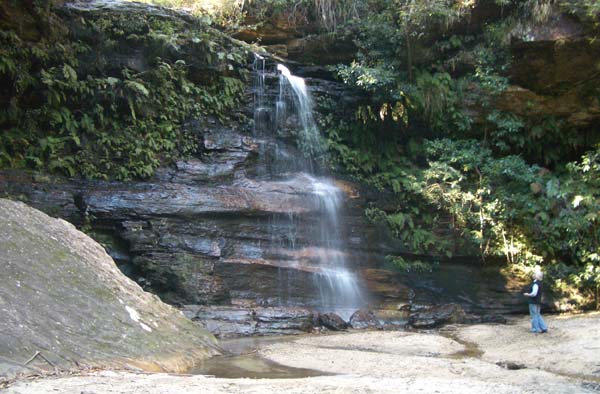 Last week we walked in the hills south of the "mid-mountains" town of Lawson (we're "upper mountains" here in Katoomba). Here's Christine admiring one of the waterfalls en route. It looks like a beach, and it is, except that it's at 700 m. above sea level: the Blue Mountains are all sandstone, heaved up from an ancient seabed eons ago, so it's not unusual to find areas of pure sand as you walk. |
Return to home page
Read March 2008 blog Read February 2008 blog
Read January 2008 blog Read December 2007 blog Read November 2007 blog
Read October 2007 blog Read September 2007 blog
Read August 2007 blog Read June 2007 blog
Read May 2007 blog Read April 2007 blog Read March 2007 blog
Read February 2007 blog Read January 2007 blog Read December 2006 blog
Go to my 2001-2 Australia travel book